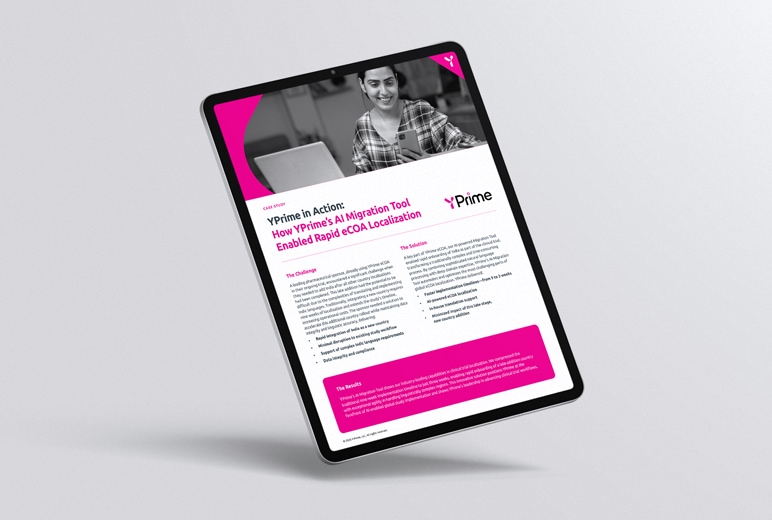Electronic clinical outcome assessments (eCOAs) and electronic patient-reported outcomes (ePROs) have emerged as the new standard for collecting patient data in clinical trials. Yet, as studies grow longer, more complex, and more costly, the challenge lies not just in implementing these solutions but in ensuring they remain effective and relevant for years to come.
YPrime’s Donna M. Mongiello, RN, BSN (Senior Vice President of eCOA Strategy) recently presented about the importance of a fully configurable, multi-tenant eCOA platform at the 2024 Innovation Network Gathering.
Take a listen here:
Innovation and quality are at the core of everything we do as an industry to improve clinical trials. That’s why every year, we participate in the Innovation Network Gathering—a forum for brilliant minds from various backgrounds to come together to engage in thought-provoking discourse that sparks new opportunities for growth and change.
Drawing from industry expertise, here are three (3) essential strategies for futureproofing your eCOA solutions.
- Embrace User-Centric Design for Better Clinical Trial Outcomes
When implementing eCOA platforms, success begins and ends with the user experience. Clinical trials depend heavily on patient engagement, and an intuitive ePRO software design can dramatically impact data quality and completion rates. Through comprehensive user experience research, we’ve learned that creating effective ePRO solutions requires more than just functional technology—it requires a deep understanding of the human element.
This understanding starts with asking the right questions and, more importantly, listening to the answers. Who are our users? What are their technology comfort levels? How do they interact with digital tools in their daily lives? By incorporating these insights into your design process, you can create eCOA solutions that naturally fit into users’ lives rather than disrupting them. The result is more than just user-friendly technology; it’s technology that actively encourages engagement and promotes better data collection. - Leverage Multi-Tenant Architecture for Scalable eCOA Solutions
Modern eCOA solutions demand scalability, and multi-tenant architectures provide the foundation for achieving this. Unlike single-tenant solutions that require individual updates for each instance, a multi-tenant eCOA platform operates from a unified code base across all clinical trial projects. This approach means that when one study benefits from an improvement or update, all studies can potentially benefit from that same enhancement.
This architectural choice has far-reaching implications for the future of your clinical trials. When regulatory requirements change or protocol amendments arise, updates can be implemented efficiently across the entire platform. This not only reduces maintenance costs but also ensures consistency and compliance across all studies. The ability to rapidly adapt and scale is not just an advantage—it’s a necessity. - Prioritize Configurability in Clinical Outcome Assessments
The future of electronic assessments in clinical trials lies in configurability. Today’s eCOA platform must be able to adapt quickly to changing requirements without extensive custom development. Through feature toggles and flexible configuration options, you can rapidly deploy changes that would have previously required weeks or months of development time.
Think of configurability as building with advanced LEGOs rather than carving from stone. Need to add a new assessment type? Toggle it on. Need to modify data collection parameters? Adjust the configuration. This approach ensures your eCOA solution can evolve alongside your clinical trials, providing the perfect balance between standardization and customization.
Looking Ahead
As clinical trials continue to evolve, a robust, futureproof eCOA solution becomes increasingly valuable. Success in this space requires more than just implementing ePRO software for clinical trials—it demands a forward-thinking approach that anticipates and adapts to change. By focusing on user-centric design, multi-tenant architecture, and configurability, organizations can build technology platforms that not only meet today’s needs but remain effective and efficient for years to come.
To explore another conversation led by YPrime’s Donna M. Mongiello, RN, BSN on patient engagement, click here.
Check Out Our Other eCOA Resources
about trial design, data capture, operational efficiencies, and, ultimately, solving for certainty in clinical research.


